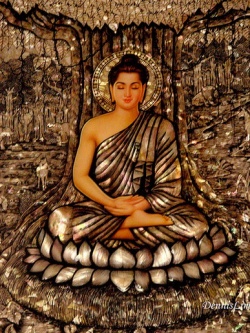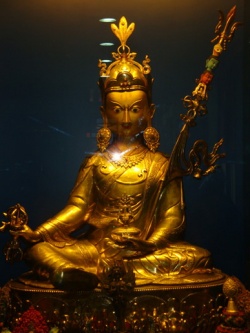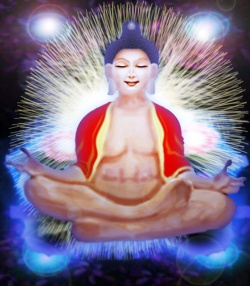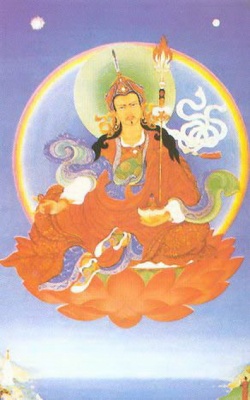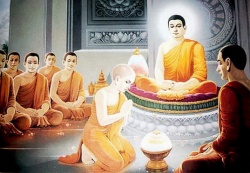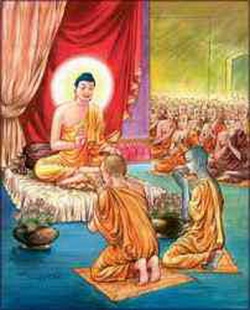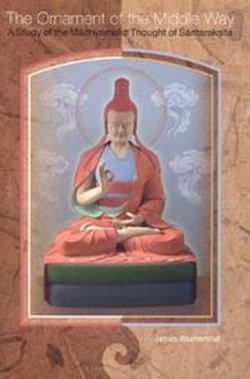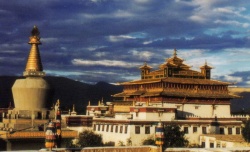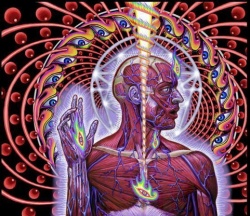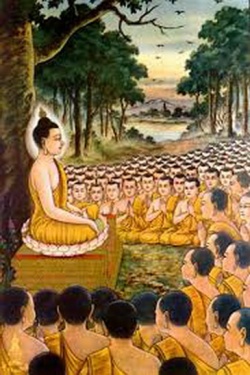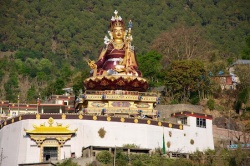Prayer for propagation of the teachings of the Khyentse lineage
Jamyang Khyentse Wangpo who is the master of the ocean-like Remay teachings of Tibet The Lord who wields the wonderful Seven Special Direct Blessings and Manjushri Himself in person.
May his teachings spread, prosper and grow! Gang Jong Rime Tempa Gyatso dak Ngo Tsar Ka Bab Dun Kyi Khorlo Gyur Jampal Yang Ngo Khyentse Wangpo Yi Ring Luk Tenpa Dargye Tashi Shok
NOTES TO THE ENGLISH TRANSLATION.
Jamyang Khyentse Wangpo who is the master of the ocean-like Remay teachings of Tibet The Lord who wields the wonderful Seven Special Direct Blessings and Manjushri Himself in person.
May his teachings spread, prosper and grow! Gang Jong Rime Tempa Gyatso dak Ngo Tsar Ka Bab Dun Kyi Khorlo Gyur Jampal Yang Ngo Khyentse Wangpo Yi Ring Luk Tenpa Dargye Tashi Shok
1. Viewing self identities: The Tibetan term "bDag.tu.lta.ba." is difficult to translate, there seems to be no exact equivalent in English.
bDag - means "I" or self. Here, it also has the further meaning of ownership, something which owns its own characteristics.
Ita.ba. - means view, to look, the act of looking. When used philosophically, it involves a decision that has been finalised, for instance, you decide that this is a book and your belief that this is a "book" causes your relative appearance of the book, Every being has a view: it is said that Buddha's view of phenomena is non-dualistic, a Madhyamikan's view is emptiness, and when ordinary people see phenomena, they make an automatic decision, that the object is that particular object, and so that is the way the object appears to them.
Dag.tu.ta.wa - is the view that objects and subjects have self-identities of their own.
2. Non-virtue occurs because we do not know cause and effect. In order to eliminate this particular ignorance, Buddha taught the Four Noble Truths:
(i) that we are suffering,
(ii) that there is a cause to our suffering,
(iii) that we can attain 'Nirvana' or the cessation of suffering,
(iv) that by taking the Path we can be led away from suffering and its causes.
3. This refers to any view which involves a subject and object, or a duality. When it is said that "Buddha's view of phenomena is non-dualistic" (see note 1) it is from a sentient being's viewpoint. In actuality, Buddha has no view because there is nothing, other than Himself, which he views.
4. These Three Trainings are:
(i) Training in the Law of the Way (Tib: tsul.trim which is often translated as the
Discipline of Morality, but here it has been translated literally from the Tibetan).
(ii) Training in Holding the Deep (Tib: ting.nge.dzin usually translated as
Concentration).
(iii) Training in Excellent Wisdom
5. Sacred Writings (Tib: sDe.sNod. often translated as Basket) have three major divisions: Sutras, Vinaya and Abhidharma.
6. Five categories combined together form the Sutra Section teaching Concentration; four categories form the Vinaya Section teaching Morality and three categories form the Abhidharma Section teaching Wisdom.
7. Tantric Yogis (Tib: rig.pa.dzin.pa) literally translated as "Awareness Holder".
8. Which are collectively known as the Kangyur.
9. (More than two hundred volumes) collectively known as the Tangyur.
10. The Six Ornaments are the six great Indian Saints: Nagarjuna, Asanga, Aryadeva, Vasubandhu, Dignaga and Dharmakirti.
11. Those who have gone beyond samsara.
12. Before the religious persecution of King gLang.Darma from 836 to 842 A.D.
13. The Cause Vehicle (rgyud.yi.theg) involves methods of practice for the collection of merit and wisdom, which are the causes of Buddhahood.
14. The Result Vehicle ('bras.theg.) involves methods of practice where one has the complete authority to visualise oneself as Enlightened etc. Thus, one is said to be practising the result, Buddhahood.
15. The Secret Tantra has four classes: Kriya, Carya, Yoga and Anuttarayoga. The first three are called "Outer" Tantras because they are more common than the last, which is called "Inner" Tantra. The Three Inner Tantras, subdivisions of the Highest Yoga Tantra (Skt: Anuttarayoga Tantra) are:
(i) The Mahayoga Tantric Vehicle, which corresponds to the Male Tantras, emphasises the Development Stage and the Method aspect.
(ii) The Anuyoga Tantric Vehicle, which corresponds to the Female Tantras, emphasises the Completion Stage and Wisdom aspect.
(iii) The Atiyoga Tantric Vehicle, which corresponds to he non-dual Tantras, gives equal emphasis to both the Developing and Completion Stages, and to both Method and Wisdom.
16. The Five Great Masters were: Kunga Nyingpo, Sonam Tsemo, Dragpa Gyaltsen (known as the "Three White Masters"), the Sakya Pandita - Kunga Gyaltsen and Chogyal Phagpa (known as the "Two Red Masters").
17. The four major Kagyud Lineages are: the Baram, the Phagdru, the Karma Kamtzang and the Dagpo.
18. The eight minor Kagyud Lineages are: the Drigung, Taklung, Yelpa, Marpa, Shugseb, Lingre (or Drukpa), Yabzang and Throphu.
19. The lineage from Vajradhara, through Tilopa, Naropa, Marpa and Milarepa to Gampopa, is referred to as the "General" Kagyud Lineage because it is the source of all Kagyud Traditions. Gampopa had many disciples and the four major lineages came from his four main disciples. They were: the first Karmapa, Dusum Khyenpa, who founded the Karma Kamtsang Kagyud tradition; Tsultrim Nyingpo, who received the lineage of Gampopa's monastery, (Daglha Gompa), and continued the tradition known as Dagpo Kagyud; Baram Darma Wangchuk, who left Dagpom travelled north and settled in Baram, gave instructions on meditation. His tradition became known as the Baram Kagyud. The last disciple, Khampa Dorgyal, the most 'expansive' teacher' of the group, also went north and built a monastery in a place called Phagmodru. He became known as Phagmo Drupa and his tradition, the Phagdru Kagyud.
From the vast quantity of teachings which Phagmo Drupa received, he passed different instructions on to his many various disciples, and in so doing, gave rise to the eight minor lineages. (See Note 18)
All these lineages produced a large number of Siddhas and Incarnation Lamas.
20. This figure is not to be taken literally, but to mean 'many'.
21. Earth Treasures (Tib: gter.ma) include discovered representations of: the Holy Body of the Buddha, such as statues and images; the Holy Speech of the Buddha, such as Dharma, including special condensed texts (sometimes in gold or other precious materials); and the Wisdom Mind of the Buddha, such as dorjes (symbols of Wisdom), and phurbas (symbols of Buddha Activity). Other precious treasures discovered include medicines, amrita, hidden holy places, etc.
22. The highest human emanations are holy Incarnations who reveal these Treasures. They are called Tertons. In Tibet there were five King Tertons and more than one thousand other Tertons. These five are Pema Lingpa, Guru Chowang, Rigzin Godem, Sangye Lingpa and Jamyang Khyentse Pema Ozel Dongag Lingpa, whose incarnation is the author and translator of this text, and an emanation of King Trisong Deutson.
23. The three standard criteria for establishing validity are:-
(i) direct perception
(ii) inference, based upon pure logic and
(iii) inference, based upon scriptural authority,
24. Samsara (Tib: 'khor.ba), literally 'perpetual wandering' or 'cyclic existence', is the continuous process of going through birth and death without control. All this is caused by our ignorance and its actions (For more details see Note 29.)
25. The Ten Non-Virtuous Actions are:
Three of Body:
(i) Killing
(ii) Stealing
(iii) Sexual Misconduct
Four of Speech:
(iv) Lying
(v) Divisive Speech
(vi) Harsh Speech
(vii) Idle Speech (or gossip)
Three of Mind:
(viii) Covetousness
(ix) Ill Will
(x) Wrong Views
The ten virtuous actions are the opposite of these.
26. For example, the four karmic results of killing (depending on the karmic weight of
the action) are:
(i) Rebirth in one of the lower realms.
(ii) When reborn human, one experiences illness, a short life and being killed.
(iii) Having the tendancy to kill, doing the action of killing again.
(iv) Being Born in a country where there is a lot of killing, where medicine is not effective and food does not give nourishment.
27. Virtue inevitably results in happiness and non-virtue inevitably results in sorrow or suffering. Just as it is impossible for an apple seed to give rise to a poisonous plant, in the same way, it is impossible for virtue to result in unhappiness.
28. This inevitable ripening of stored karmic seeds is illustrated in many examples in the Sutras, where we find descriptions of events which had arisen due to karmic seeds planted aeons before. However, it should be remembered that if one uses the four Opponents Powers (of Confession) it is possible to completely destroy these unripened karmic seeds so that their results will never be experienced, (See Note 41)
29. The Law of Interdependent Origination (Tib: rten.brel.bcu.gnyis) is an explanation of the wheel of cyclic existence. Understanding this can free one from Samsara. There are twelve links of Interdependent Origination:
1. Ignorance (of the True Nature of Reality and of karma) subjects one to all the miseries of existence and causes one to continually circle in Samsara. From this ignorance
2. Predispositions arise. From predispositions
3. Consciousness arises. Just as a monkey in a tree only sees the jungle from the viewpoint of the branch he occupies, so too, how our six consciousness experience our realm depends upon previous dispositions and actions. From consciousness
4. Name and Form are produced. These are the four aggregates of mind (name) and the one of form. They constitute an individual. From these
5. The Six Sense Organs grow and develop in the womb. When they meet with their six respective objects.
6. Contact results. From contact
7. Feelings of pleasure or displeasure etc. arise. Then
8. Craving, which is the desire for happiness (arising from feelings of pleasure) and the desire to be free from suffering (arising from feelings of displeasure) is produced, causing
9. Grasping. From this
10. Becoming is produced. From becoming
11. Birth is engendered. If there is birth there is sickness,
12. Death and perhaps, old age.
1. and 2. are causes created in one life giving rise to the conditions 3. to 10. in a later life. 11. and 12. are conditions pertaining to a life subsequent to these.
30. The six classes of sentient beings are:
those in the three lower realms:
(i) hell beings
(ii) hungry ghosts
(iii) animals
and those in the three upper realms:
(iv) humans
(v) anti-gods
(vi) gods (of desire, form and formless).
31. The Three Spheres of Existence encompass every possible state of existence in which one can take rebirth in Samsara (as do the six realms). These three spheres:
(i) The Realm of Desire: where the five senses function, comprising (i) to (v) in Note 30 and the gods of desire.
(ii) The Realm of Form: a god realm of ethereal bodies, consisting of four levels obtained through the four concentrations.
(iii) The Realm of Formlessness: the highest god realm where beings are born without form and with only the aggregate of mental consciousness. Again there are four levels Corresponding to the four formless absorptions.
32. The general sufferings which afflict every being bound to cyclic existence are:
(i) The suffering of suffering: which includes all unpleasant experiences, from intense physical pain and mental anguish to milder sensations of dissatisfaction. It is this suffering which is clearly recognisable to all beings, including animals.
(ii) T he suffering of change: which includes all pleasant experiences. All Samsaric happiness comes to an end because it is conditioned. It arises from ignorance and karma and is therefore said to be contaminated. Some contaminated feelings appear to be pleasant, but are merely the appearances of happiness. Their true nature is not happiness because they are only a temporary halt to suffering.
(iii) The pervasive suffering of conditioned existence: the five contaminated aggregates, (see Note 46) which comprise the individual, are produced by the power of previous ignorance and actions, and being thus conditioned, they are pervaded by suffering. They continually possess the seeds of all the suffering which will ripen for us, they possess the ignorance which produces more suffering, including all our future rebirths, and they are the basis upon which all suffering of this life manifests. This is the most difficult of all the sufferings to perceive and understand.
33. Particular sufferings: hell beings suffer intense heat or cold spirits have dissatisfaction, animals are exploited, humans have birth, sickness, old age, death, separation, meeting the unpleasant etc.
34. Defiled virtuous actions are virtuous actopns created without Wisdom.
35. Worldly Concentration (Tib: 'jig.rten.pa.yi.ting.dzin) means concentration which is not mixed with Wisdom.
36. Bodhicitta (Tib: byang.chub.kyi.sems) includes the Absolute Bodhicitta, which is the Pure View of Reality and Relative Bodhicitta and is distinguished into:
(i) Wishing to attain Buddhahood in order to liberate all sentient beings from cyclic existence, and
(ii) Participating in the activities and practices of a Bodhisattva, in order to bring about the achievement of this goal.
37. The Seven Branches are: Prostrations, Offerings, Confession, Rejoicing, Requesting Holy Ones to Remain, Requesting them to turn the Wheel of Dharma and Dedication of merits to the Enlightenment of all beings.
38. The "Bodhisattva's Confession of Downfalls (Tib: byang.chub.ltung.bshags)" is the Sutra of Declaration before the Thirty-Five Buddhas.
39. The Four Opponent Powers are:
(i) Taking refuge in the Buddha, Dharma and Sangha, and generating Bodhicitta.
(ii) Regretting the non-virtuous action which you wish to purify.
(iii) Promising not to repeat the action.
(iv) Doing some virtuous actions to purify the negative karma, such as reciting Vajrasattva mantra, doing prostrations etc.
40. The Nine Stages of Abiding Mind (sems.gnas.dgu) are:
1. Focussing the mind (sem.'jog.pa) or literally 'mind placement'. - One's attention is focused on one object. This stage is attained when one's concentration can be maintained for twenty-one breaths.
2. Continual Focussing (rgyun.du.'jog.pa). Here one constantly returns to the object where the mind wanders.
3. Patch-like Concentration (glan.te.'jog.pa). Here, as soon as mental wanderings occur one is aware of it.
4. Close Focussing (nye.ba.'jog.pa). The mind is no longer wandering, mind and object have become almost inseparable. The obstacle here is gross mental dullness.
5. Taming (dul.ba.byed.pa). Subtle dullness is dealt with.
6. Pacifying (zhi.ba.byed.pa). Subtle agitation is dealt with.
7. Total Pacification (rnam.par.zhi.ba.byed.pa) of dullness and agitation.
8. Single-Pointed Concentration (rtze.gcig.tu.byed.pa). One's object remains as long as desired.
9. Focussing with Equanimity (Mnyam.par.'jog.pa). This stage is the highest concentration attainable in the Realm of Desire. The full attainment of Samatha goes beyond into the Realms of Form and Formlessness.
41. The Five Downfalls (nyes.pa.lnga) are:
(i) Laziness (le.lo)
(ii) Forgetting the verbal advice received (gdams.ngag.brjed.pa) and the object of
meditation.
(iii) Dullness and Agitation (bying.rgo)
(iv) Not applying the remedies ('du.mi.byed)
(v) Appling the remedies when unnecessary ('du.byed).
42. The eight compounded mental faculties ('du.byed.brgyad), antidotes to the five downfalls, are:
(i) Faith
(ii) Aspiration
(iii) Effort
(iv) Physical and mental pliancy
(v) Mindfulness
(vi) Awareness
(vii) Application
(viii) Desisting from application.
43. The Five Aggregates (Tib: phung.po, Skt: Skandha) comprising the individual are: form, feeling, perception, predispositions and consciousness.
44. Madhyamika (Tib: 'dbU.ma) or Middle Way, is the Mahayana philosophical school established by Nagarjuna and his disciple Aryadeva. It is called the "Middle Way" because it avoids the extremes of eternalism (belief in existence) and nihilism (brief in non-existence). Through the analysis and examination of both, one arrives at that which lies in between, which cannot be logically tested or demostrated. These teachings are in accordance with the Buddha's second turning of the wheel of Dharma. They are included in all versions of the "Prajnaparamita", and are further explained in the "Mula Prajna " by Nagarjuna> and the "Mahyamakavatara" by Chandrakirti.
45. The eight extremes are
1. Birth,
2. Cessation,
3. Eternalism,
4. Nihilism,
5. Coming,
6. Going,
7. Not different meaning and 8. Not same meaning.
46. The Five Paths (lam.lnga) of the Mahayana are:
(i) The Path of accumulation of merit (Tsog.lam). Bodhicitta and the power of Samadhi are attained on this path. This and the second path are those of ordinary beings.
(ii) T he Path of Application (sByor.lam). Here one develops a greater insight into Emptiness. When this path is completed the Samsaric path ends and that of Noble Beings (Aryas) commences.
(iii) The Path of Seeing (thong.lam). Before the attainment of this path, Emptiness is confused with one's image of it. Here the first Bodhisattva Bhumi is attained. (See Note 50)
(iv) The Path of Meditation (sGom.lam) develops greater familiarity with Emptiness and traverses the second through to the tenth Bhumi.
(v) The Path of No More Learning. Here, the practitioner enters Buddhahood.
47. There are ten stages through which a Bodhisattva progresses on his way to Buddhahood. These Ten Bodhisattva Stages are:
1. The Joyful One (rab.tu.dga.'ba)
2. The Stainless One (du.ma.med.pa)
3. The Illuminating One ('od.byed.pa)
4. The Radiant One ('od.'phro.Ba)
5. The One Difficult to Conquer (shin.tu.sbyangs.dka'.ba)
6. The One Becoming Clearly Obvious (mngon.du.gyur.ba)
7. The One Which Goes Far (ring.du.song.ba)
8. The Unshakable One (mi.gyo.ba)
9. The One Having Good Discrimination (legs.pa'i.blos.gros)
10.Cloud of Dharma (chos.kyi.sprin)
48. King Krikri had many prophetic dreams, the tenth of which showed eighteen people tearing a piece of cloth into eighteen pieces.
NOTES TO HEART ADVICE.
1. This work was translated by the Ven. Sogyal Rinpoche in France, August 1981.
2. "Rigpa" is translated as "Awareness", but there is really no English word which can capture its meaning.
3. This refers to the prayer to be reborn in the Pure Land Realm of Guru Rinpoche, the Copper Coloured Mountain (Tib: Zandok Palri).
